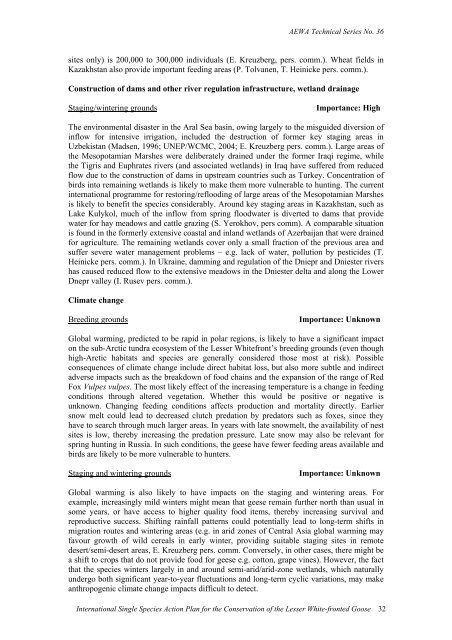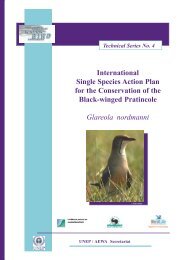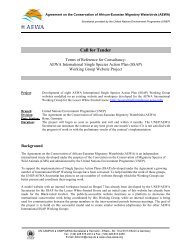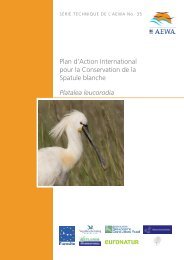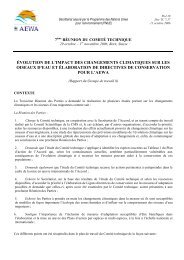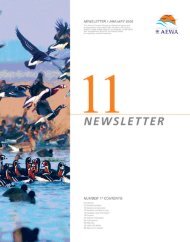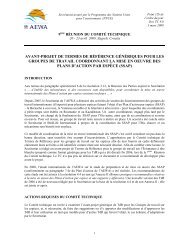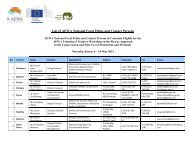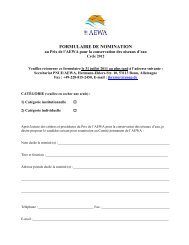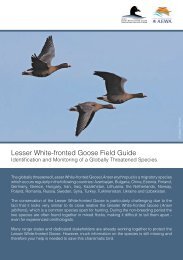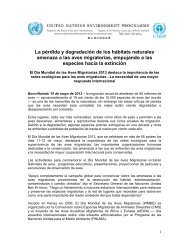International Single Species Action Plan for the ... - AEWA
International Single Species Action Plan for the ... - AEWA
International Single Species Action Plan for the ... - AEWA
Create successful ePaper yourself
Turn your PDF publications into a flip-book with our unique Google optimized e-Paper software.
<strong>AEWA</strong> Technical Series No. 36<br />
sites only) is 200,000 to 300,000 individuals (E. Kreuzberg, pers. comm.). Wheat fields in<br />
Kazakhstan also provide important feeding areas (P. Tolvanen, T. Heinicke pers. comm.).<br />
Construction of dams and o<strong>the</strong>r river regulation infrastructure, wetland drainage<br />
Staging/wintering grounds<br />
Importance: High<br />
The environmental disaster in <strong>the</strong> Aral Sea basin, owing largely to <strong>the</strong> misguided diversion of<br />
inflow <strong>for</strong> intensive irrigation, included <strong>the</strong> destruction of <strong>for</strong>mer key staging areas in<br />
Uzbekistan (Madsen, 1996; UNEP/WCMC, 2004; E. Kreuzberg pers. comm.). Large areas of<br />
<strong>the</strong> Mesopotamian Marshes were deliberately drained under <strong>the</strong> <strong>for</strong>mer Iraqi regime, while<br />
<strong>the</strong> Tigris and Euphrates rivers (and associated wetlands) in Iraq have suffered from reduced<br />
flow due to <strong>the</strong> construction of dams in upstream countries such as Turkey. Concentration of<br />
birds into remaining wetlands is likely to make <strong>the</strong>m more vulnerable to hunting. The current<br />
international programme <strong>for</strong> restoring/reflooding of large areas of <strong>the</strong> Mesopotamian Marshes<br />
is likely to benefit <strong>the</strong> species considerably. Around key staging areas in Kazakhstan, such as<br />
Lake Kulykol, much of <strong>the</strong> inflow from spring floodwater is diverted to dams that provide<br />
water <strong>for</strong> hay meadows and cattle grazing (S. Yerokhov, pers comm). A comparable situation<br />
is found in <strong>the</strong> <strong>for</strong>merly extensive coastal and inland wetlands of Azerbaijan that were drained<br />
<strong>for</strong> agriculture. The remaining wetlands cover only a small fraction of <strong>the</strong> previous area and<br />
suffer severe water management problems – e.g. lack of water, pollution by pesticides (T.<br />
Heinicke pers. comm.). In Ukraine, damming and regulation of <strong>the</strong> Dniepr and Dniester rivers<br />
has caused reduced flow to <strong>the</strong> extensive meadows in <strong>the</strong> Dniester delta and along <strong>the</strong> Lower<br />
Dnepr valley (I. Rusev pers. comm.).<br />
Climate change<br />
Breeding grounds<br />
Importance: Unknown<br />
Global warming, predicted to be rapid in polar regions, is likely to have a significant impact<br />
on <strong>the</strong> sub-Arctic tundra ecosystem of <strong>the</strong> Lesser Whitefront’s breeding grounds (even though<br />
high-Arctic habitats and species are generally considered those most at risk). Possible<br />
consequences of climate change include direct habitat loss, but also more subtle and indirect<br />
adverse impacts such as <strong>the</strong> breakdown of food chains and <strong>the</strong> expansion of <strong>the</strong> range of Red<br />
Fox Vulpes vulpes. The most likely effect of <strong>the</strong> increasing temperature is a change in feeding<br />
conditions through altered vegetation. Whe<strong>the</strong>r this would be positive or negative is<br />
unknown. Changing feeding conditions affects production and mortality directly. Earlier<br />
snow melt could lead to decreased clutch predation by predators such as foxes, since <strong>the</strong>y<br />
have to search through much larger areas. In years with late snowmelt, <strong>the</strong> availability of nest<br />
sites is low, <strong>the</strong>reby increasing <strong>the</strong> predation pressure. Late snow may also be relevant <strong>for</strong><br />
spring hunting in Russia. In such conditions, <strong>the</strong> geese have fewer feeding areas available and<br />
birds are likely to be more vulnerable to hunters.<br />
Staging and wintering grounds<br />
Importance: Unknown<br />
Global warming is also likely to have impacts on <strong>the</strong> staging and wintering areas. For<br />
example, increasingly mild winters might mean that geese remain fur<strong>the</strong>r north than usual in<br />
some years, or have access to higher quality food items, <strong>the</strong>reby increasing survival and<br />
reproductive success. Shifting rainfall patterns could potentially lead to long-term shifts in<br />
migration routes and wintering areas (e.g. in arid zones of Central Asia global warming may<br />
favour growth of wild cereals in early winter, providing suitable staging sites in remote<br />
desert/semi-desert areas, E. Kreuzberg pers. comm. Conversely, in o<strong>the</strong>r cases, <strong>the</strong>re might be<br />
a shift to crops that do not provide food <strong>for</strong> geese e.g. cotton, grape vines). However, <strong>the</strong> fact<br />
that <strong>the</strong> species winters largely in and around semi-arid/arid-zone wetlands, which naturally<br />
undergo both significant year-to-year fluctuations and long-term cyclic variations, may make<br />
anthropogenic climate change impacts difficult to detect.<br />
<strong>International</strong> <strong>Single</strong> <strong>Species</strong> <strong>Action</strong> <strong>Plan</strong> <strong>for</strong> <strong>the</strong> Conservation of <strong>the</strong> Lesser White-fronted Goose 32


